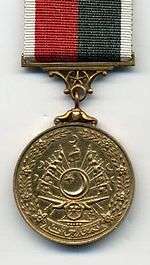Ghulam Murtaza Malik (Shaheed)
| Shaheed Ghulam Murtaza TJ | |
|---|---|
| Native name | Ghulam Murtaza Malik |
| Born |
5 November 1941 Kahuta, Rawalpindi District, British India |
| Died | 17 December 1971 (aged 30) |
| Allegiance |
|
| Service/branch |
|
| Years of service | 1958–1971 |
| Rank | Flight Lieutenant |
| Battles/wars | Indo-Pakistani War of 1971 |
| Awards | Tamgha-i-Jurat |
Flight Lieutenant Ghulam Murtaza Malik (Urdu: ملک غلام مرتضی شہید) was born in a religious family of Malik Kala Khan; Kahuta, Rawalpindi.
Life and Early Education
He was born on 5 Nov 1941, in the Awan tribe of Kahuta. He received his early education from Govt High School Kahuta, Rawalpindi. He lost his father, while he was still in teens. His first cousin, Malik Habib became Federal Interior Minister of Pakistan – Interim Government in 2013.
Military career
He joined Pakistan Air Force (PAF) as an aircraft technician on June 19, 1958. As a promising aviator, Malik served on various flight lines and showed extraordinary performance. It was during these days that he developed a passion to become an officer of the PAF. His wish came true in June 1963 when he was selected to undergo officer training at Pakistan Air Force Academy, Risalpur. Resilient Malik showed all round performance during training. After spending two eventful years at Academy, Malik earned his commission on January 30, 1966 and passed out as an operational navigator. Malik showed great potential in flying and soon earned enviable reputation among his peers.[1]
Indo-Pakistani War 1971
He was a very active member of the squadron and always showed great enthusiasm and determination. He flew two missions against the most heavily defended Indian airfields and showed great bravery and courage in the execution of these missions in complete disregard of personal safety. On 5 December 1971, he was detailed as navigator on a bombing mission to Amritsar airfield. As the crew dropped the bombs on the target, a barrage of lethal ack-ack fire struck the aircraft. Both the crew members ejected from the burning aircraft, inside the enemy territory. He received serious head injuries while ejecting. He fell unconscious during parachute descent and was later captured by the Indian troops. After being captured, he was admitted to a military hospital near New Delhi.[2]
Death
On December 17, 1971, the unsung hero met his eternal destiny at the hospital in New Delhi. The East Pakistan had fallen 24 hours before his demise. Soon the arrangements were made by the Indian authorities for the burial of the brave officer in line with the Muslim rituals.
Burial in Nizamuddin Auliya Graveyard
It was decided that the great soldier would be laid to rest in Nizamuddin Auliya graveyard, in Dehli. Pakistani flag, arranged from the Saudi Embassy at New Delhi, was wrapped around the casket of the martyr. He was put to rest in eternal abode in the presence of thousands of mourners. For his courage, determination and devotion to duty he has been awarded the Tamgha-i-Jurat.
Awards and decorations

| Tamgha-i-Jurat (TJ) | |